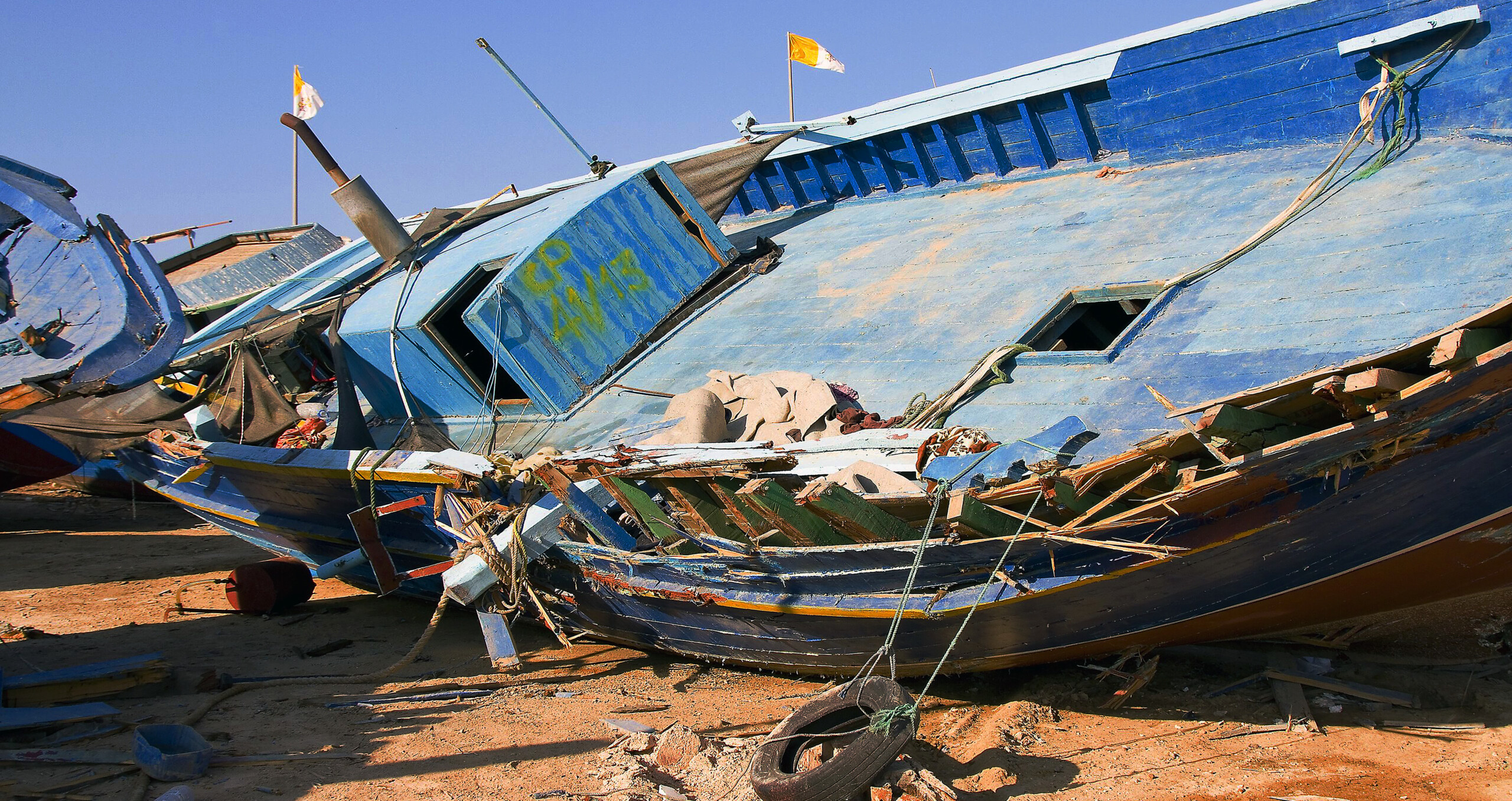Italy responsible for over 200 migrants’ deaths in shipwreck

Broken, clandestine boats in Lampedusa harbor. Lampedusa is a primary European entry point for migrants. Photo by Natursports (Shutterstock, 2013).
Italy responsible for over 200 migrants' deaths in shipwreck
A report published by the United Nations Human Rights Committee has found that Italy did not maintain its responsibility to protect the right to life of over 200 migrants in a 2013 shipwreck (UN News, 2021a).
What happened?
On October 10, 2013, a fishing vessel carrying over 400 migrant passengers, both adults and children, departed Libya in the early hours of the morning. Around 113km south of Italy’s Lampedusa island (and 218km south of Malta), the vessel was shot at by another boat, which was reportedly wielding a Berber flag. The boat carrying the migrants soon began to flood, and so a passenger contacted the Italian emergency sea operators to report that the boat was sinking, providing their location. The Italian authorities were called multiple times over the next few hours (United Nations, 2021).
Hours after the initial call to the Italian emergency authorities, at around 1pm, the boat passengers were informed that their situation had been forwarded to Malta’s authorities as they were in fact in Maltese water. The Italian operator, then, simply passed on the telephone number of Malta’s Rescue Coordination Centre to the caller, who proceeded to make several calls to this number whilst the vessel and its passengers’ condition continued to deteriorate (United Nations, 2021).
It took until almost 6pm for the Maltese rescue services to reach the sinking vessel, that had capsized by this time, which was finally followed by an Italian navy ship (ITS Libra) joining the rescue scene (United Nations, 2021).
Too little, too late
By the time the vessel carrying the migrants was reached by the Maltese and Italian boats, more than 200 passengers had drowned. Of these deaths, over a quarter (60) of them were children. The large gap between the first call made by the passenger on the sinking vessel and the time the scene was reached resulted in many deaths which could, and should, have been prevented (United Nations, 2021).
As a result of Italy’s mishandling of the situation, four survivors of the wreck filed a joint complaint against the Italian authorities for their dismissive and delayed response to a number of courts, and to the UN Human Rights Committee (United Nations, 2021).
The committee has found that the Italian authority’s response ultimately violated the passengers’ right to life and failed to comply with the International Covenant on Civil and Political Rights (UN News, 2021a). This is a piece of international legislation that protects a number of civil liberties, including the right to life (United Nations, 1976).
Hélène Tigroudja, a committee member, commented that had the Italian authorities responded immediately, the vessel would have been reached before it sank, saving hundreds of lives. She stated, “Even though the sinking vessel was not located in Italy’s search and rescue zone, the Italian authority had a duty to support the search and rescue mission to save the lives of the migrants” (United Nations, 2021).
Italy’s migrant policies in the spotlight
This is not the only report that has come to light this year about Italy’s questionable migration and asylum practices.
Italy came under fire earlier this year for their handling of migrants during the pandemic. Since May 2020, asylum seekers in Italy have been sent to quarantine on ships following their arrival in the country (D’Ignito, 2021).
Although these ships, which are based off the shores of Sicily, were initially intended as a temporary solution whilst alternative accommodation was found, this has not been the case. Aboard these ships, there have been numerous shocking incidents which have led to humanitarian organizations condemning the practice (D’Ignito, 2021).
A Tunisian man drowned after jumping overboard of one of these ships trying to reach land, and nine other Tunisian men swallowed razorblades in an attempt to take their own lives whilst onboard. Further concern was brought on by the death of two teenage boys in hospital following their evacuation from a boat in October 2020. Although the cause of death has not been disclosed, it has been reported that they had been kept on the boat even though they were clearly seen to be malnourished, dehydrated, and showed signs of having been tortured (D’Ignito, 2021).
Tragedy at sea
The European refugee crisis is not something new. Refugees arriving in Europe are often fleeing war, violence, and persecution in their homes. The journey itself can be treacherous, many arriving by sea on unsafe, clandestine vessels. Due to their location in the Mediterranean, Italy, Malta, Greece, Spain, and Cyprus encounter large numbers of migrant arrivals (over 27,000 in 2019 alone).
The Central and Western Mediterranean route saw an increase in crossings in 2020, 154% (34,100) and 46% (35,800) respectively, whilst the rate of those reported dead or missing in the same year decreased from the previous. However, with 1,754 people reported dead or missing, this figure is still worryingly high (EU Commission, 2021).
A call for aid
This tragic story from 2013 is just one of many. Reportedly, from 2013-2020 over 17,000 asylum seekers and migrants have died or gone missing on the Central Mediterranean route, the crossing from North Africa to Europe (Camilli & Paynter, 2021).
In January 2021, it was reported that 43 people had died in a shipwreck in the Mediterranean off the coast of Libya, trying to cross to Europe. The decrease in rescue operations in the Mediterranean over the last few years is being attributed to an increase of deaths in this area.
The International Office for Migration (IOM) and the United Nations High Commissioner for Refugees (UNHCR) are calling for stricter procedures to be implemented in the region in prevention, rescue, and post-rescue operations, in order to reduce such fatalities (UN News, 2021b).
Justice for the lost
Following the UN Human Rights Committee’s conclusion on the investigation of the 2013 shipwreck, Italy must now proceed to conduct its own investigation into what happened. This will include bringing to justice those who played a role in the mishandling of the rescue, and also to provide remedy for the families of the over 200 people who drowned (United Nations, 2021).
As more migrants inevitably continue to make this dangerous crossing in search of a better future, the IMO and UNHCR’s calls for improved practices are hoped to prevent the continuation of preventable losses of life.

Article by
Costadina Tsoukala-Steggell

Categories
Categories, Countries, Equality, Europe, Human rights, Immigration, Italy, News, Refugees


